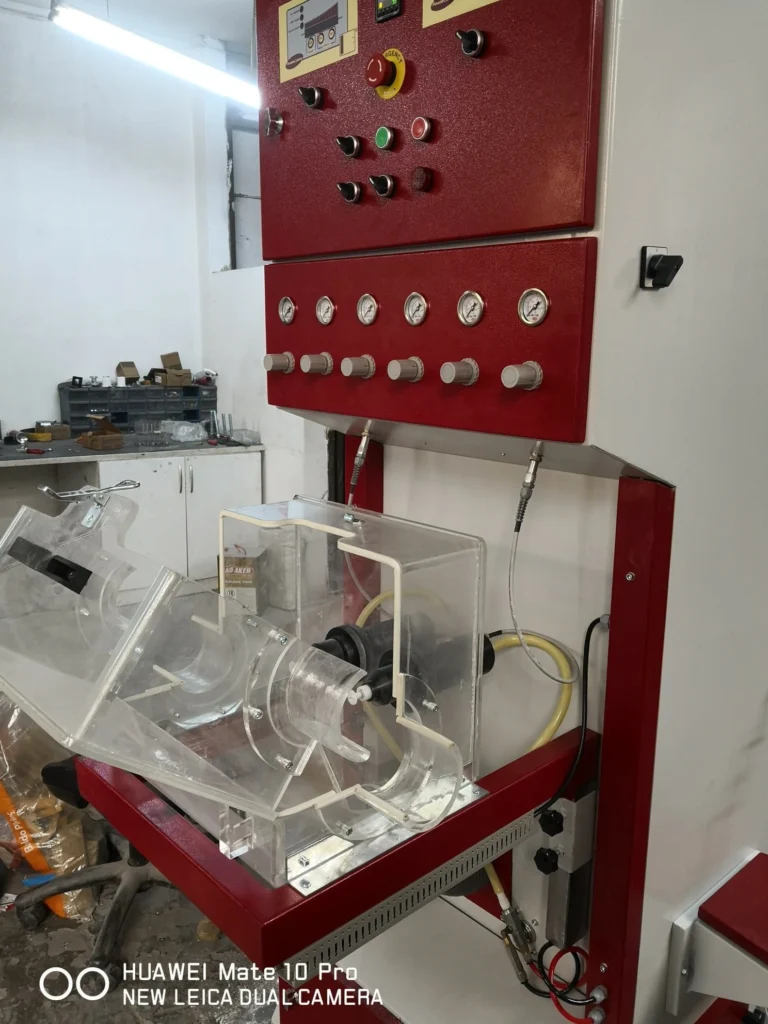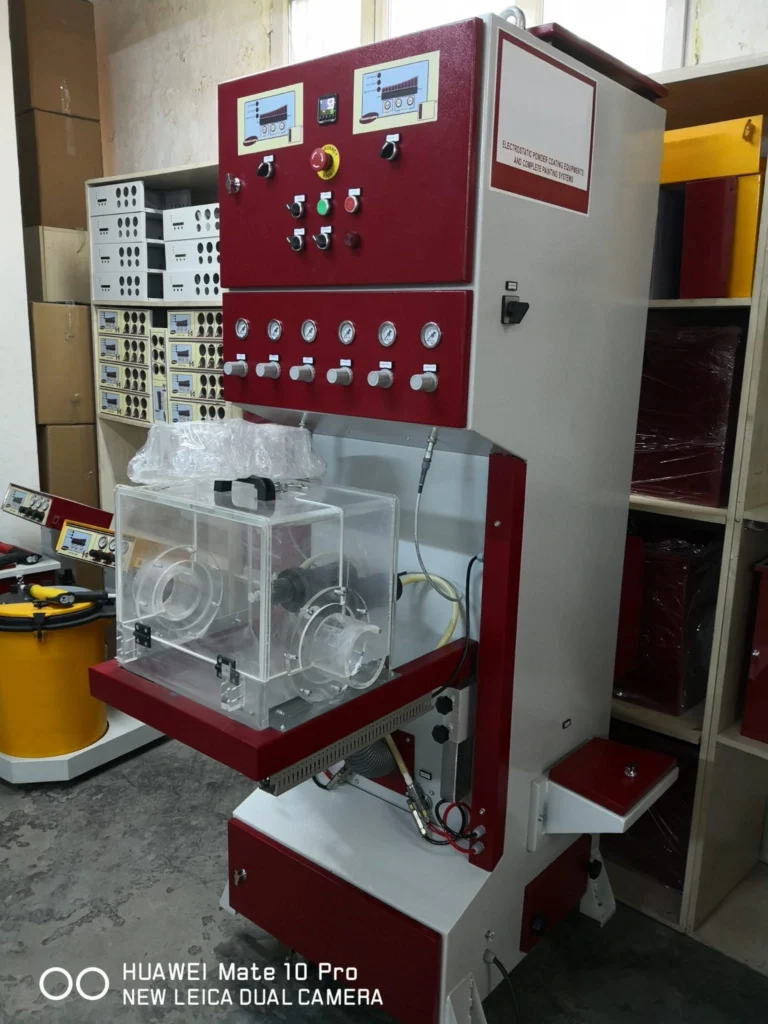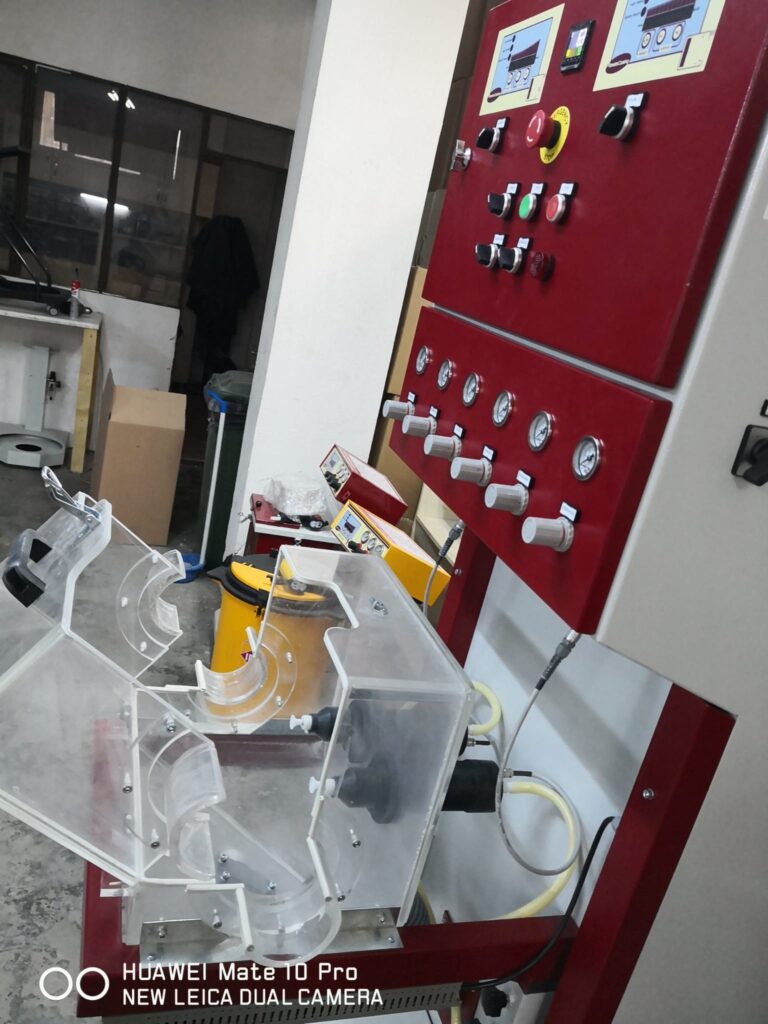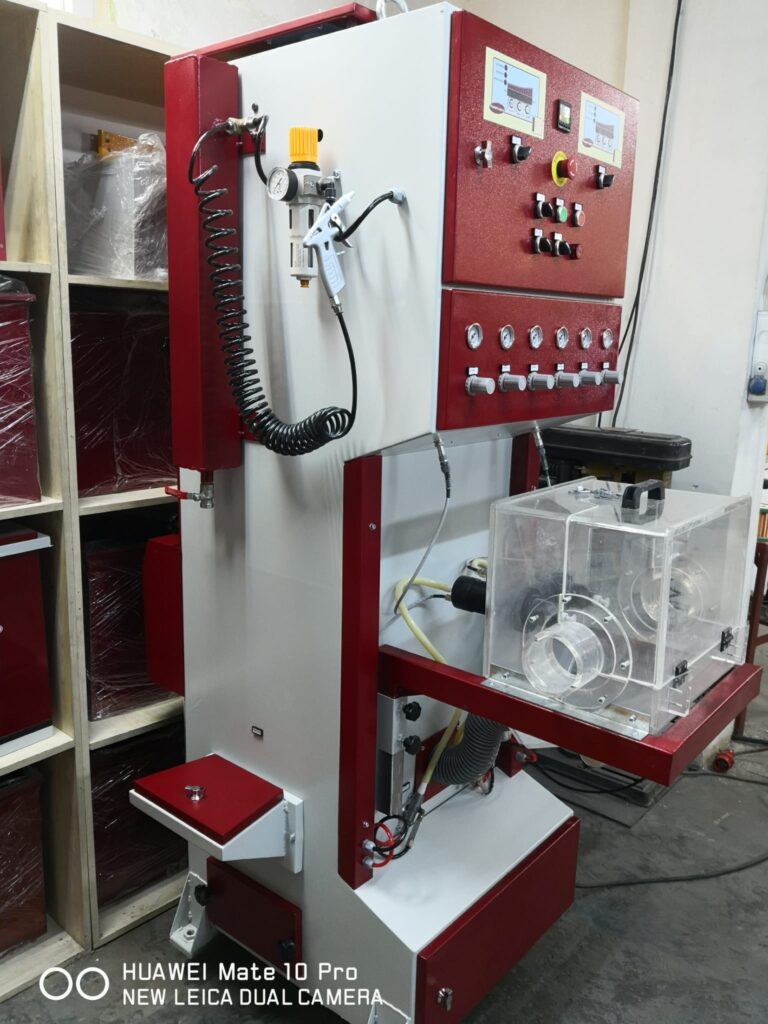
A talc applicator is a device used to apply talcum powder to cables. Talcum powder is a mineral that is used as a lubricant to reduce friction between the cable and its sheath. It is also used to protect the cable from moisture and dust.
There are two main types of talc applicators:
- Longitudinal applicators: These applicators are placed directly against the extruder, and the cable runs through them. The talcum powder is applied to the cable as it passes through the applicator
- Crosshead applicators: These applicators are placed at the crosshead of the extruder, where the cable is extruded. The talcum powder is applied to the cable before it is cooled and solidified.
Talc applicators are typically used in the production of electrical cables, such as power cables, data cables, and coaxial cables. They can also be used in the production of other types of cables, such as automotive cables and optical fiber cables.
Here are some of the benefits of using a talc applicator:
- Reduces friction: Talcum powder is a lubricant that reduces friction between the cable and its sheath, which can help to extend the life of the cable.
- Protects from moisture and dust: Talcum powder can help to protect the cable from moisture and dust, which can damage the cable and cause it to fail.
- Improves appearance: Talcum powder can give the cable a smooth, finished appearance.
If you are considering using a talc applicator, it is important to choose one that is the right size for your cables and that is compatible with your extruder. You should also make sure that the talcum powder you use is food-grade and that it is free of contaminants.
Talc Applicator for Cable
A cable talc applicator, also known as a cable powder applicator or cable dusting machine, is a specialized device used to apply talcum powder to cables. Talcum powder is a soft, inert mineral that acts as a lubricant and insulator, protecting cables from friction, wear, and corrosion. Cable talc applicators are commonly used in the manufacturing and maintenance of electrical cables, particularly for high-voltage and fiber optic cables.
Purpose of Talc Applicators for Cables
- Lubrication: Talcum powder reduces friction between the cable conductors and the cable jacket or insulation, minimizing wear and tear during cable handling and installation.
- Insulation: Talcum powder provides additional insulation between the cable conductors, preventing electrical short circuits and enhancing the cable’s dielectric strength.
- Moisture Protection: Talcum powder absorbs moisture, helping to protect cables from corrosion caused by humidity and water exposure.
- Dust and Debris Protection: Talcum powder creates a protective layer on the cable surface, preventing dust, debris, and contaminants from adhering to the cable.
Applications of Talc Applicators for Cables
- Electrical Cable Manufacturing: Talc applicators are used to apply talcum powder to electrical cables during the manufacturing process, ensuring smooth cable handling and protection during production and transportation.
- Cable Installation: Talc applicators are employed in cable installation projects to apply talcum powder to cables as they are pulled through conduits or ducts, reducing friction and protecting the cables from damage.
- Cable Maintenance: Talum applicators are used to apply talcum powder to existing cables during maintenance and repair operations, providing lubrication and protection against wear and corrosion.
- Fiber Optic Cable Protection: Talcum powder is specifically used in the manufacturing and maintenance of fiber optic cables to protect the delicate fiber strands from damage and ensure optimal signal transmission.
Types of Talc Applicators for Cables
- Manual Talc Applicators: These applicators consist of a handheld container with a perforated top for dispensing talcum powder onto the cable. They are suitable for small-scale applications or spot treatments.
- Semi-Automatic Talc Applicators: These applicators incorporate a motor-driven auger or impeller to mechanically dispense talcum powder onto the cable. They offer increased efficiency and control over powder application.
- Automatic Talc Applicators: These applicators are integrated into cable manufacturing or laying equipment, providing continuous and automated talcum powder application throughout the cable processing or installation process.
Factors to Consider When Choosing a Talc Applicator for Cables
- Cable Size and Type: Select an applicator with a suitable powder dispensing mechanism and capacity to accommodate the cable size and type.
- Application Rate and Consistency: Choose an applicator that can deliver the desired application rate and ensure consistent powder distribution along the cable length.
- Dust Control: Consider the applicator’s dust control features to minimize the spread of talcum powder particles in the working environment.
- Portability and Ease of Use: Assess the applicator’s portability and ease of use, especially for manual or semi-automatic types.
- Integration with Existing Equipment: If integrating the applicator into existing cable processing or installation equipment, ensure compatibility and proper interface mechanisms.
Conclusion
Talc applicators play a crucial role in the manufacturing, maintenance, and protection of various types of cables, particularly electrical and fiber optic cables. By applying talcum powder, these applicators provide lubrication, insulation, and protection against wear, corrosion, and moisture damage, extending the lifespan and reliability of cables in various applications.
Longitudinal applicators
Longitudinal applicators are devices used to apply longitudinal tapes to cables. They are typically used in the production of electrical cables, such as power cables, data cables, and coaxial cables. Longitudinal applicators can also be used in the production of other types of cables, such as automotive cables and optical fiber cables.
Longitudinal applicators consist of a frame, to which a combination of different tools can be attached. The applicator starts with a pre-forming flute and is then followed by fixed steel dies, in two steps, which press the tape against the cable.
Longitudinal applicators are typically placed directly against the extruder, and the cable runs through them. The talcum powder is applied to the cable as it passes through the applicator.
There are several benefits to using longitudinal applicators, including:
- Improved cable performance: Longitudinal applicators can help to improve the performance of cables by reducing friction, protecting them from moisture and dust, and improving their appearance.
- Increased production efficiency: Longitudinal applicators can help to increase production efficiency by automating the process of applying longitudinal tapes to cables.
- Reduced costs: Longitudinal applicators can help to reduce costs by reducing the amount of waste and rework that is required.
If you are considering using a longitudinal applicator, it is important to choose one that is the right size for your cables and that is compatible with your extruder. You should also make sure that the tape you use is of good quality and that it is free of contaminants.
Here are some of the key components of a longitudinal applicator:
- Frame: The frame provides the structure for the applicator and supports the other components.
- Pre-forming flute: The pre-forming flute helps to shape the tape before it is applied to the cable.
- Fixed steel dies: The fixed steel dies press the tape against the cable, ensuring that it is applied evenly and securely.
- Tension control system: The tension control system ensures that the tape is applied with the correct amount of tension.
- Drive system: The drive system moves the cable through the applicator.
Longitudinal applicators are an essential piece of equipment for any cable manufacturer. They can help to improve the quality and performance of cables, while also increasing production efficiency and reducing costs.
Crosshead Applicators
Crosshead applicators are devices used to apply crosshead tapes to cables. They are typically used in the production of electrical cables, such as power cables, data cables, and coaxial cables. Crosshead applicators are placed at the crosshead of the extruder, where the cable is extruded. The talcum powder is applied to the cable before it is cooled and solidified.
Crosshead applicators are typically used in conjunction with longitudinal applicators to apply both longitudinal and crosshead tapes to cables. They can also be used to apply other types of tapes, such as armor tapes and identification tapes.
There are several benefits to using crosshead applicators, including:
- Improved cable performance: Crosshead applicators can help to improve the performance of cables by reducing friction, protecting them from moisture and dust, and improving their appearance.
- Increased production efficiency: Crosshead applicators can help to increase production efficiency by automating the process of applying crosshead tapes to cables.
- Reduced costs: Crosshead applicators can help to reduce costs by reducing the amount of waste and rework that is required.
If you are considering using a crosshead applicator, it is important to choose one that is the right size for your cables and that is compatible with your extruder. You should also make sure that the tape you use is of good quality and that it is free of contaminants.
Here are some of the key components of a crosshead applicator:
- Frame: The frame provides the structure for the applicator and supports the other components.
- Tape unwinder: The tape unwinder unwinds the tape from its roll and feeds it to the applicator.
- Tape guide: The tape guide guides the tape onto the cable.
- Pressure roller: The pressure roller applies pressure to the tape to ensure that it is adhered to the cable.
- Cutter: The cutter cuts the tape to the desired length.
- Drive system: The drive system moves the cable through the applicator.
Crosshead applicators are an essential piece of equipment for any cable manufacturer. They can help to improve the quality and performance of cables, while also increasing production efficiency and reducing costs.
The talc applicator, we have developed is of the longitudinal type where the cable runs through it. Composed of a talc chamber and a hopper, this machine is placed directly against the crosshead of the extruder.
A mixing unit placed in the powder chamber will guarantee a continuous mixing of the powder and a constant film on the wires. Further along the machine, an endless screw will bring back to the mixing area the excess powder falling from the wire on its way to the crosshead. At each end of the chalk applicator, an air wiper will gently blowback the powder trying to escape from around the cable, keeping your factory as clean as possible. The talc chamber is completely sealed to avoid any leak to the outside of the machine.
Powder and Talc Applicator for Cable

The team has developed methods to apply both the existing talc and liquid lubricants. The team has also developed methods for removing any excess lubricant. Three methods were developed to apply the liquid onto the wire. The first consists of running the wire around pulleys that are lined with sponge material that is soaked with lubricant. Another option consists of spraying the lubricant onto the wire.
The third option consists of dipping the wire into a liquid bath. Three methods were developed for liquid removal. The first two remove the liquid by evaporation as the wire is passed through a tube filled with hot air or through a xing of air jets. The third method consists of a device called an air wipe, which uses pressurized air to blow off the excess. For the talc application, the team developed three methods.
The existing solution at General Cable consists of a vibrating hopper, in which wire is guided through talc powder. An alternate method consists of passing the wire through a chamber in which talc is kicked into the air by a rotating wheel. Another method consists of passing the wire under a talc-filled sifter, which meters the correct amount onto the wire (Ref. 6.3). Four methods were developed to remove excess powder. The first two methods consist of a rotating and vibrating brush respectively.
Another method uses a bead chain to knock excess off the moving wire (see illustration at bottom left). The fourth option consists of vibrating the wire directly by bringing a vibrating post in contact with it (Ref. 6.4). When these concepts were presented to engineers at General Cable, they expressed a preference for a liquid lubricant.
Of the three liquid application methods presented, the sponge method was dismissed based on the extremely abrasive conditions to which the sponge would be subjected. The spray nozzle concept was dismissed based on air pollution concerns.
The liquid dip method was preferred because it is a proven method. The methods chosen to remove excess include an air wipe followed by a hot air tube. The air wipe removes the majority of the liquid, while the hot air tube evaporates the remaining volatile liquids, leaving the solids on the wire. The air ring concept was dismissed based on the belief that it would not be as effective as the air tube.
In light of the requirements, a powder coating is much more likely to provide a solution than a lubricant. In order to adequately investigate all the potential solutions, however, powder lubricants were considered from the beginning of the project. Powder application methods were therefore developed to complement the liquid application methods.
Applying Talc Powder on Cables
Investigation into the differences between liquids and powders led to the development of powder application methods distinct from liquid application methods. There are three conceptual powder application designs in this section: one that passes the wire through a thin layer of falling powder, one which passes wire through a cloud of powder, and one which passes the wire through a hopper of vibrating powder. In all these cases, the powder tends to adhere to the surface of the wire due to the tackiness of the insulation at the time of application.
Two screens move back and forth against each other to control the metering of the powder. A small motor powers this motion, and the powder is gravity-fed into the screens. The speed of the sifter controls the amount of powder applied. Small rollers are included to support and guide the wire.
The advantage of the talc sifter is that by controlling the amount of talc applied to the wire, lubricant removal devices may not be required. However, this method requires the talc metering process to precisely control the amount of talc applied. The catch tray must also be emptied periodically, and the device may need to be enclosed: so that talc doesn’t migrate into the work environment. This method may require frequent maintenance, as the sifter could get clogged often.


